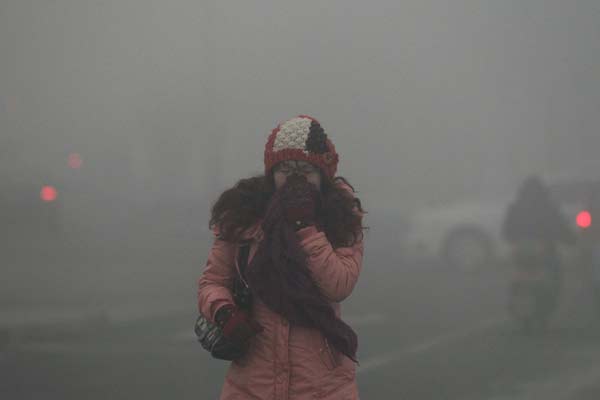Minister unveils measures to cut pollution
Updated: 2013-01-25 07:35
By Wu Wencong (China Daily)
|
||||||||
The program to combat pollution will place greater emphasis on monitoring, gathering and releasing information and tackling PM2.5, the minister leading the fight for cleaner air told a major anti-pollution conference.
Environment Minister Zhou Shengxian said on Thursday that 39 more cities will start monitoring PM2.5 and release the readings to the public by December.
Similar monitoring was initiated by 74 cities in 2012. Readings of PM2.5 - particles whose diameters are smaller than 2.5 micrometers that can enter the lungs and bloodstream - are one of the six indicators that are being publicized. The other five are readings of sulfur dioxide, nitrogen dioxide, respirable particulate matter (PM10 or smaller), ozone and carbon monoxide.
Zhou was addressing the 2013 environmental protection work conference.
He said emissions of nitrogen oxides in 2012 were reduced by 2.8 percent compared with 2011 levels, and sulfur dioxide by 4.5 percent.
 |
|
A woman covers her nose when walking through dense fog caused by heavy pollution in Beijing on Tuesday. [Bai Jikai / for China Daily] |
The new target in 2013 for nitrogen oxide reduction, largely due to vehicle exhaust, has been raised to 2.5 percent from 2 percent.
Zhou hoped that all cities will aim to get PM2.5 levels lower than 35 micrograms per cubic meter. About 70 percent of cities fail to meet the current clean-air standard.
He set a timeline for cities with different levels of pollution to meet standards.
"Cities with major air pollution exceeding the standard by less than 15 percent should try to get it within the standard by 2015. Those that exceed the standard by between 15 to 30 percent should try to reach the goal by 2020. And those that are emitting more than 30 percent beyond the standard should make long-term plans and try to set a deadline of 2030," said Zhou.
According to Hong Feng, deputy mayor of Beijing, the capital can be included in the third group of cities.
Zhou said the recent smog across the country affected 600 million people in 17 provinces, autonomous regions and cities that cover about one-fourth of the country.
To get the problem under control in the long run, Zhou said the ministry is considering launching a working group to tackle pollution.
In a plan released by the ministry in early December, 13 key regions were highlighted to combat PM2.5.
"Those regions are the most heavily polluted and densely populated," said Zhao Hualin, director of the ministry's pollution prevention department. The annual mean PM2.5 level will be reduced by 5 percent by 2015 in 10 of the key regions according to the plan.
For the other three - the Beijing-Tianjin-Hebei industrial cluster, Yangtze River Delta Economic Zone and the Pearl River Delta Economic Zone - the reduction target is set higher at 6 percent.
"More than 100 days per year, these three regions are enveloped in haze," said Zhao.
Experts have been worrying about the feasibility of cooperation among different cities within a region, calling for detailed legal explanations.
As the Chinese Lunar New Year draws near, Zhou targeted firecrackers and fireworks.
"PM2.5 readings on New Year's Day in 2012 reached as high as 1050 (mcg per cu m)," he said. Even during the recent pollution in mid-January the highest level of PM2.5 was 900 mcg per cu m.
wuwencong@chinadaily.com.cn
Related readings:
Emission of major pollutants reduces in China
Stricter car emission rules to fight pollution
Anti-pollution plan gets mixed reviews
Pollution hits Shanghai but should clear in a day
Pollution triggers breathing woes
Beijing moves to curb prolonged haze pollution
Beijing air pollution reaches dangerous levels
Fog, haze lead to big spike in pollution levels

 Li Na on Time cover, makes influential 100 list
Li Na on Time cover, makes influential 100 list
 FBI releases photos of 2 Boston bombings suspects
FBI releases photos of 2 Boston bombings suspects
 World's wackiest hairstyles
World's wackiest hairstyles
 Sandstorms strike Northwest China
Sandstorms strike Northwest China
 Never-seen photos of Madonna on display
Never-seen photos of Madonna on display
 H7N9 outbreak linked to waterfowl migration
H7N9 outbreak linked to waterfowl migration
 Dozens feared dead in Texas plant blast
Dozens feared dead in Texas plant blast
 Venezuelan court rules out manual votes counting
Venezuelan court rules out manual votes counting
Most Viewed
Editor's Picks

|

|

|

|

|

|
Today's Top News
Boston bombing suspect reported cornered on boat
7.0-magnitude quake hits Sichuan
Cross-talk artist helps to spread the word
'Green' awareness levels drop in Beijing
Palace Museum spruces up
First couple on Time's list of most influential
H7N9 flu transmission studied
Trading channels 'need to broaden'
US Weekly

|

|







